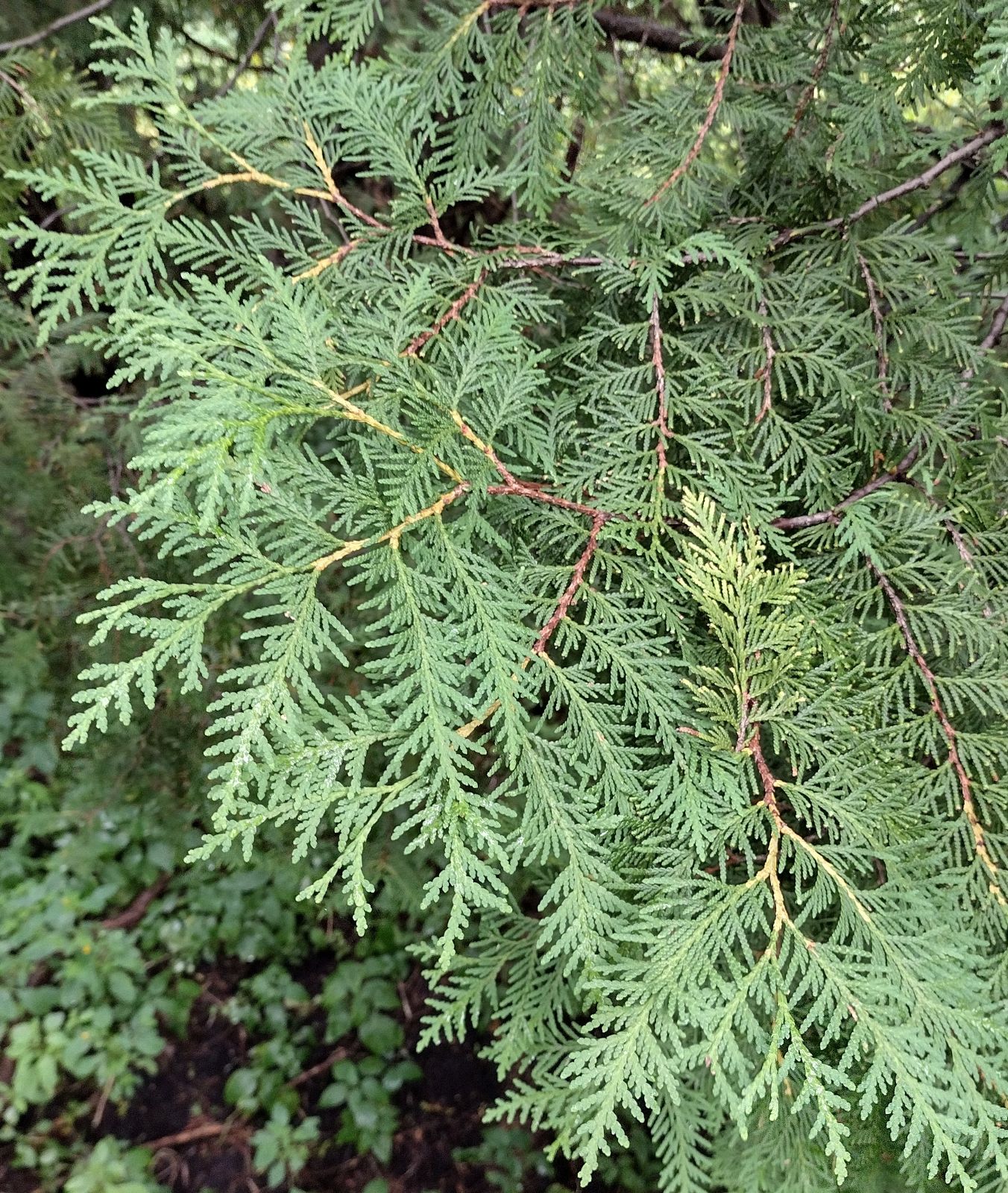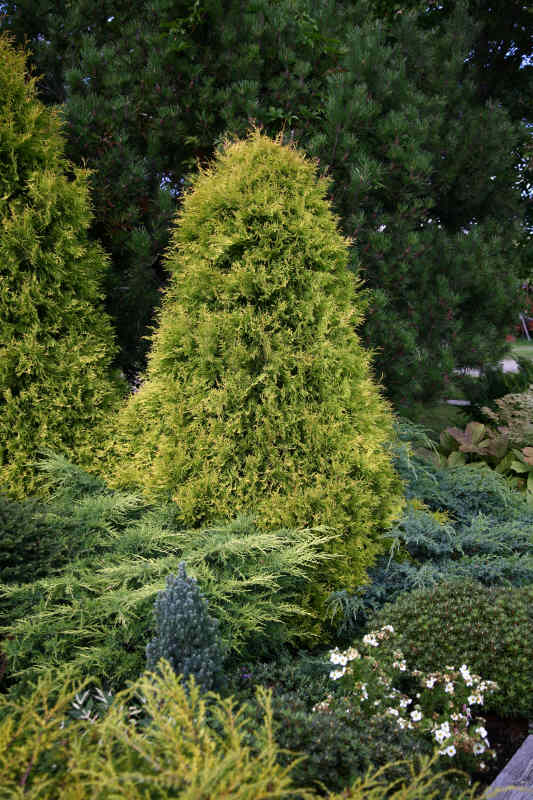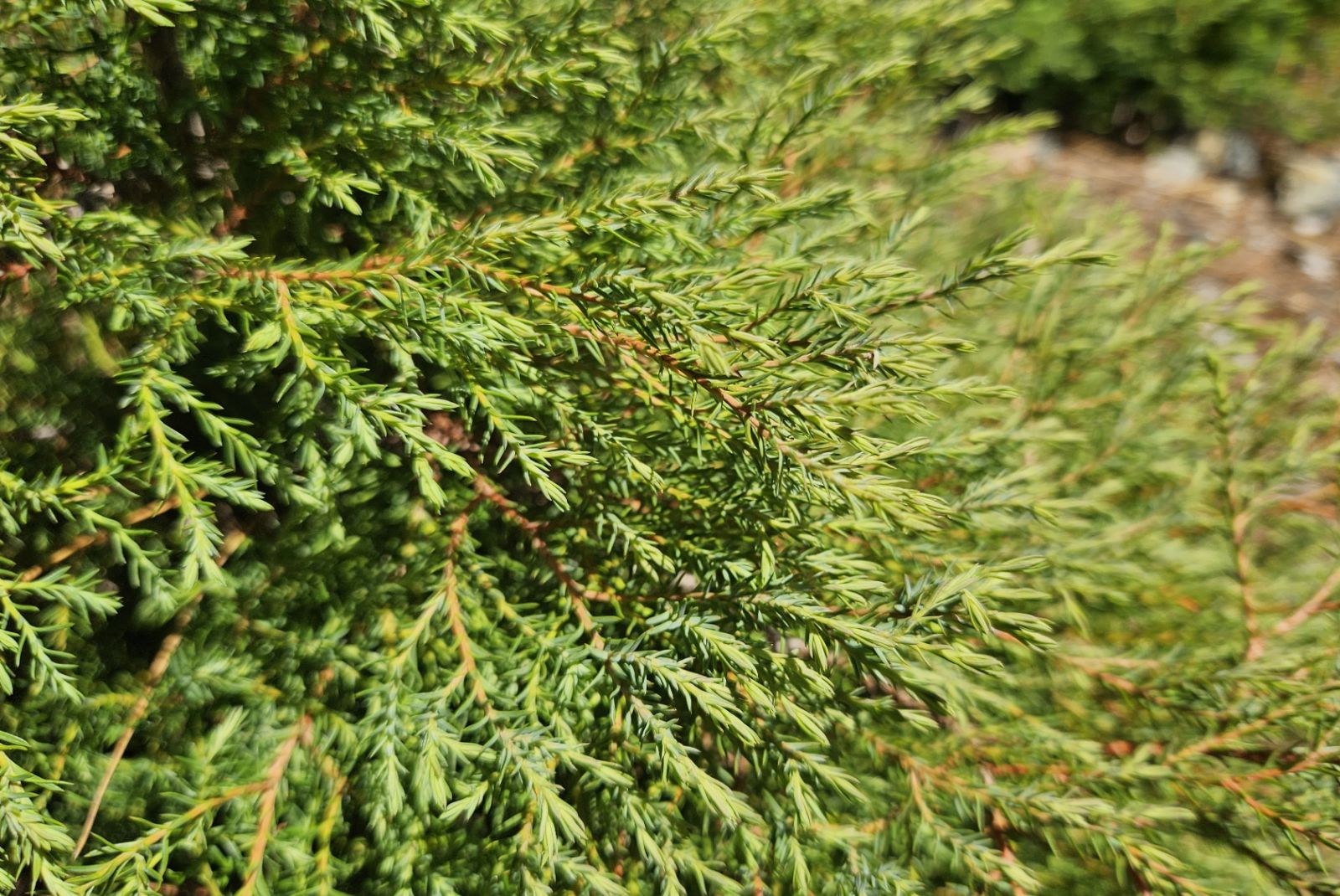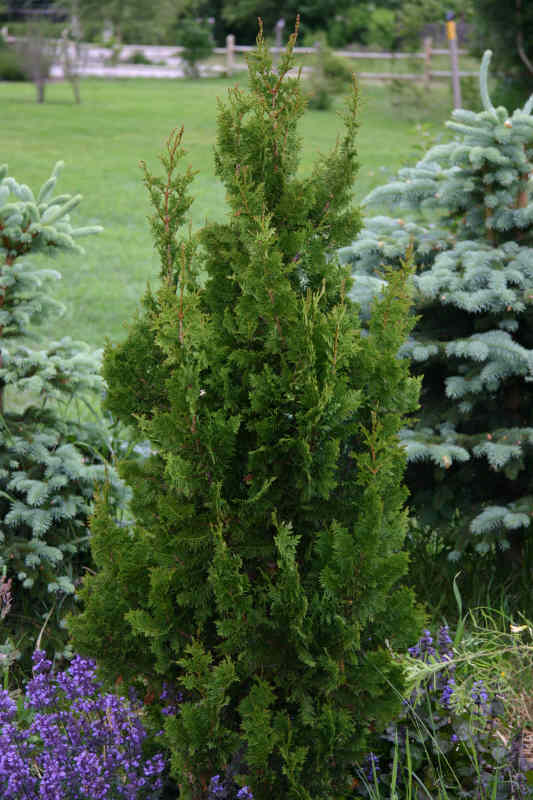Thuja occidentalis
Credits
Article from Bean's Trees and Shrubs Hardy in the British Isles
Recommended citation
'Thuja occidentalis' from the website Trees and Shrubs Online (treesandshrubsonline.
Genus
Common Names
- White Cedar
- Arbor Vitae
Infraspecifics
Other taxa in genus
An evergreen tree, 50 to 60 ft high, with a trunk 2 to 3 ft in diameter; in cultivation a pyramidal shrub or tree rarely more than half as high; branches usually upturned towards the end; branchlets three or four times pinnate, the ultimate subdivisions much flattened, 1⁄16 to 1⁄12 in. wide. Leaves scale-like, about 1⁄12 in. long, the lateral ones pointed, prominently keeled and overlapping the middle ones; they are a dull yellowish green above, paler and grey green beneath (not with whitish patches, as in T. plicata), the middle ones beneath are furnished with a raised roundish gland in the centre. Cones about 1⁄3 in. long, oblong, with eight or ten scales.
Native of N. America from the Gulf of St Lawrence to Manitoba, south to New York State and the region of the Great Lakes and with a scattered distribution farther south in the Appalachians; it is often found in swampy locations, but the best stands are on well drained soils. A young plant brought back from the St Lawrence by Jacques Cartier, probably in 1536, lived for many years in the royal garden at Fontainebleau and must have been one of the very first species of N. America to reach the Old World. By the time the first permanent settlements were established there it was already widely cultivated in Europe, including Britain, as the Arbor Vitae (see introductory note). According to Parkinson (Paradisus, 1629), all these trees were propagations from the original.
T. occidentalis is not in the first rank of conifers, being often thin in habit (especially on dry soils) and dull in colour, frequently putting on a yellowish brown appearance in winter. It often grows slowly, and as an ornamental conifer is much interior to its western ally T. plicata. Only three really healthy-looking specimens have been recorded recently: Little Hall, Canterbury, pl. 1906, 62 × 41⁄2 ft (1973); Carey House, Wareham, Dorset, 68 × 6 ft (1968); Trawscoed, nr Aberystwyth, 63 × 71⁄4 ft (1969). This thuya does, however, have some value for forming evergreen shelter hedges, especially in very cold areas where T. plicata does not thrive.
In previous editions it was remarked that very numerous forms of garden origin have been named, but the number available early this century was nothing compared to those raised and distributed in N. America in recent years. For a comprehensive account of these cultivars specialist works must be consulted, especially Van Ouden & Boom, Manual of Cultivated Conifers (1965), where sixteen pages are devoted to the cultivars of this species. Only the best known can be mentioned here:
From the Supplement (Vol. V)
The specimens mentioned at Little Hall are not the species but ‘Lutea’ and the Trawscoed specimen proves on further scrutiny to be nothing but a sickly T. plicata. The only recently measured specimens worthy of mention are: Alexandra Park, Hastings, Sussex, 50 × 31⁄2 ft + 31⁄2 ft and other stems (1980); Lydney Church, Glos., 46 × 41⁄2 ft (1983); Logie House, Moray, 41 × 61⁄2 ft (1981).
† cv.. ‘Danica’. – A dwarf of globose habit, with vertical sprays of dark green foliage, brownish in winter. Raised from seed in Denmark.
cv. ‘Holmstrup’. – A mutation from this with sulphur-yellow foliage has been named ‘Holmstrup Yellow’. Both were raised by Asger M. Jensen of Holmstrup, Denmark.
cv. ‘Lutea’. – This is more satisfactory than the normal form. One of two specimens at Little Hall, Canterbury, is 66 × 43⁄4 ft (1984) and at Dochfour, Inverness-shire it has reached 58 × 51⁄2 ft. The new cultivar named ‘Sunkist’ is said to be stronger-growing and of better colour; it was raised in Holland.
† cv. ‘Smaragd’. – Of narrowly pyramidal habit, with vivid green leaves, suitable for hedging. Raised in Denmark.
cv. ‘Spiralis’. – There is an example of this in the National Pinetum, Bedgebury, Kent, measuring 40 × 33⁄4 ft (1983).
'Aurea'
A large, broadly conical shrub with golden leaves, turning gold-bronze in winter.
'Beaufort'
Similar in habit to the type, but the leaves variegated with white. Raised in Holland.'Buchananii'
Branchlets very slender, with the subdivisions far apart. It makes a small, narrow tree. Raised in the USA before 1887.'Caespitosa'
A low, cushion-shaped shrublet with short and narrow sprays. It was noticed by Hornibrook growing in the Glasnevin Botanic Garden and described by him in 1923.
'Cristata'
This is very distinct in the penultimate subdivisions being curiously curved like a cock’s comb, the ultimate divisions often developed on one side only. Of lax habit, eventually 6 to 10 ft tall.'Ellwangeriana'
An inelegant lanky shrub with slender, curving branches, some of which bear typical leaves, others the needle-like leaves seen on seedlings, others again with both types of leaf. Shrubs over forty years old retain this dimorphic character. It attains a height of 10 ft in time. Raised by the American firm of Ellwanger and Barry, before 1868. ‘Ellwangeriana Aurea’ is a golden-leaved, slow-growing sport from this, raised by Späth and put into commerce in 1895.'Ericoides'
In this the whole foliage is needle-like and of the juvenile or seedling type. The plant is moderately dwarf and at first compact; later its shape is often ruined by heavy falls of snow. It was raised in the USA before 1867 and at first often called “Retinispora dubia” – Retinispora being the pseudo-genus founded on the juvenile forms of Chamaecyparis pisifera. But by 1888 it had coned in the USA and revealed itself to be a form of T. occidentalis.
f. mastersii Rehd.
Synonyms
T. occ. var. plicata Mast., not Hoopes
T. plicata Hort., not D. Don
'Fastigiata'
Of conical habit, with ascending branches. Foliage-sprays mostly held obliquely, light green. ‘Columna’, put into commerce by Späth in 1904, is said to be an improvement. See also ‘Malonyana’.'Filiformis'
A mound-like shrub, eventually attaining a large size, with thread-like stems, drooping at the tip; ultimate branchlets sparse and short.'Globosa'
Of compact, globular habit, attaining 4 or 5 ft in height and width; foliage grey-green. Raised by Smith of Worcester before 1874. Two other compact forms of moderate size are ‘Hoveyi’ with bright green leaves, raised in the USA around the middle of the last century, and ‘Woodwardii’, also of American origin, with dark green leaves. In both these the sprays tend to be held vertically as in T. orientalis. ‘Little Champion’, raised in Canada, is reported to be an improvement on ‘Woodwardii’ (Dendroflora, No. 8 (1971), pp. 58–9).
'Holmstrup'
Of dense, columnar habit, growing slowly to about 10 ft. Raised at Holmstrup in Denmark shortly before 1951. It has been recommended for dwarf hedges.'Lutea' ('George Peabody')
Leaves golden throughout the year. Of narrow habit, to 40 ft or so high. Raised in the USA and introduced to Britain around 1870. One of the finest golden conifers. There is an example in the National Pinetum, Bedgebury, pl. 1926, 34 × 3{1/4} ft (1969). ‘Lutea Nana’ is of similar colour but dwarfer. It is distinguished from ‘Ellwangeriana Aurea’ by the absence of juvenile foliage.
'Malonyana'
Of very slender, columnar habit; foliage dark green, not browning in winter. Fast-growing when young and eventually 65 ft high. The original plants, dating from the end of the last century, grow in the arboretum formed by Count Ambrozy at Mlynany (formerly Malonya) in Czechslovakia (J. P. Krouman, Gard. Chron., Vol. 154 (1963), p. 457). It is available in commerce.'Ohlendorfii' ('Spaethii')
Leaves mainly of the juvenile kind, being awl-shaped, spreading, but incurved at the tips, about {1/2} in. long, borne on stiff, erect stems; from some of these leaves spring thick shoots bearing leaves which are of the adult kind, though abnormally small. The size of the plant and the proportion of juvenile foliage, depends on the type of cutting from which it is propagated. Hornibrook found that plants raised from juvenile growths taken from the base of the plant remained dwarf and compact and retained the juvenile type of foliage. Plants from cuttings taken higher on the shoots produced mainly adult foliage.This variety was distributed by Späth towards the end of the last century, but was raised by Ohlendorf of Hamburg.'Rheingold'
Foliage mostly juvenile, bronzy yellow; young growths rosy. An ovoid shrub to about 4 ft high, much used as an associate to winter-flowering heaths. It was raised by the nurseryman Vollert of Lubeck and described in 1904 by Beissner, who emphasised that it was quite distinct from ‘Ellwangeriana Aurea’. It appears, however, that at one time some plants sent out as ‘Rheingold’ were not the true clone but propagations from juvenile foliage of ‘Ellwangeriana Aurea’. The conifer that received an Award of Merit in 1902 when shown by Turner of Slough as T. occ. ellwangeriana pygmaea aurea is unlikely to have been the true ‘Rheingold’, as has been suggested.'Spiralis'
A narrow tree to about 50 ft high, with short, densely set branchlets. Foliage dark green, arranged at the ends of the branchlets in fan-like spirals. First distinguished in the USA in 1923, but of unknown origin.










